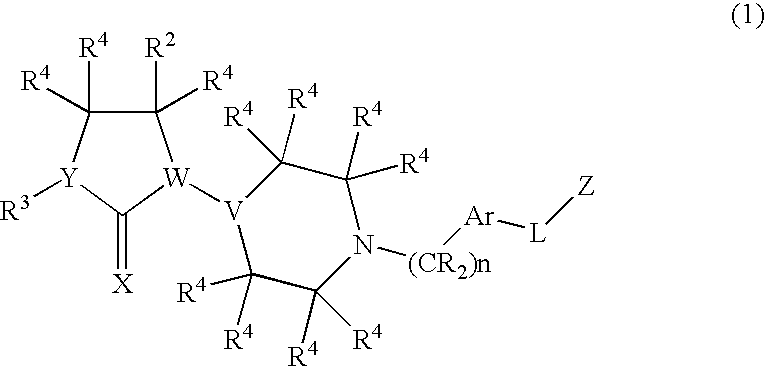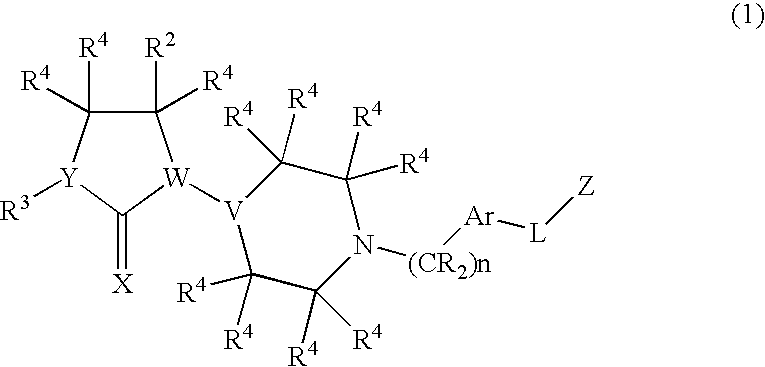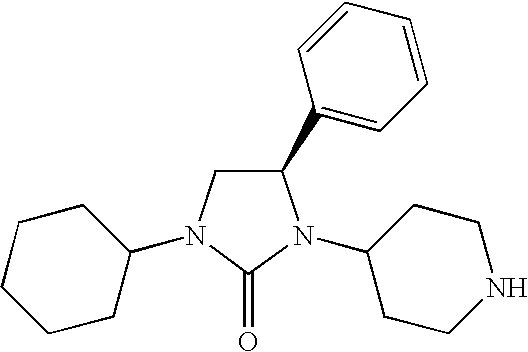Chemokine receptor binding compounds
a technology of chemokine receptors and binding compounds, which is applied in the field of new compounds and pharmaceutical compositions, can solve the problems of hematopoiesis and cardiogenesis, lethal deficiencies in vascular development, and drug compositions
- Summary
- Abstract
- Description
- Claims
- Application Information
AI Technical Summary
Benefits of technology
Problems solved by technology
Method used
Image
Examples
example 1
[0354]
COMPOUND 1: (R)-1-Cyclohexyl-4-phenyl-3-[1-(4-pyrimidin-5-yl-benzyl)-piperidin-4-yl]-imidazolidin-2-one
[0355] Using general procedure D, 5-bromopyrimidine (199 mg, 1.25 mmol) and 4-formylbenzene boronic acid (469 mg, 3.13 mmol) afforded 4-pyrimidin-5-yl-benzaldehyde (162 mg, 99%).
[0356] COMPOUND 1 was isolated as a white solid (40 mg, 68%). 1H NMR (CDCl3) δ 0.88-2.20 (m, 16H), 2.70 (d, 1H, J=11.4 Hz), 2.88 (d, 1H, J=10.4 Hz), 3.03 (dd, 1H, J=8.7, 6.9 Hz), 3.39-3.51 (m, 2H), 3.58-3.83 (m, 3H), 4.57 (dd, 1H, J=9.1, 6.6 Hz), 7.27-7.35 (m, 5H), 7.38 (d, 2H, J=8.3 Hz), 7.48 (d, 2H, J=8.1 Hz,), 8.91 (s, 2H), 9.17 (s, 1H); 13C NMR (CDCl3) δ 26.0, 29.4, 30.3, 30.8, 31.3, 48.9, 51.7, 52.5, 53.6, 53.8, 56.5, 62.7, 127.1, 128.4, 129.2, 130.4, 132.4, 133.2, 134.6, 140.2, 143.6, 155.2, 157.7, 160.6; ES-MS m / z 496 (M+1).
example 2
[0357]
COMPOUND 2: (R)-1-Cyclohexyl-4-phenyl-3-[1-(6-pyrimidin-5-yl-pyridin-3-ylmethyl)-piperidin-4-yl]-imidazolidin-2-one
[0358] To a solution of methyl 6-chloronicotinate (0.60 g, 3.50 mmol) in THF (10 mL) at −78° C. was added a solution of DIBAL-H (1 M in toluene, 10.5 mL, 10.5 mmol) and the reaction stirred from −78° C. to room temperature for 1 h. The reaction was diluted with a saturated aqueous solution of sodium potassium tartrate (25 mL) and CH2Cl2 (30 mL) and stirred vigorously overnight. The layers were separated and the aqueous layer was extracted with CH2Cl2 (2×15 mL). The combined organic extracts were dried (Na2SO4) and concentrated to afford the desired alcohol (0.48 g, 95%) as a white solid.
[0359] To a solution of the alcohol from above (481 mg, 3.35 mmol) in CHCl3 (25 mL) was added MnO2 (85%, 3.14 g, 30.7 mmol) and the suspension stirred at 60° C. overnight. The reaction was cooled, filtered through Celite®, washing the cake with CH2Cl2 and MeOH and the resultant f...
example 3
[0361]
COMPOUND 3: 4-[4-((R)-3-Cyclohexyl-2-oxo-5-phenyl-imidazolidin-1-yl)-piperidin-1-ylmethyl]-N-isopropyl-benzamide
[0362] Using general procedure E, 4-carboxybenzaldehyde (250 mg, 1.67 mmol) and isopropylamine (142 μL, 1.67 mmol) afforded 4-formyl-N-isopropyl-benzamide (300 mg, 94%).
[0363] COMPOUND 3 was isolated as a white solid (21 mg, 45%). 1H NMR (CDCl3) δ 0.91-2.11 (m, 16H), 1.24 (d, 6H, J=6.6 Hz), 2.67 (d, 1H, J=10.5 Hz), 2.85 (d, 1H, J=8.7 Hz), 3.04 (dd, 1H, J=8.7, 6.9 Hz), 3.45 (s, 2H), 3.59-3.70 (m, 1H), 3.63 (t, 1H, J=9.2 Hz), 3.76 (tt, 1H, J=11.4, 3.5 Hz), 4.27 (hex, 1H, J=6.2 Hz), 4.56 (dd, 1H, J=9.1, 6.4 Hz), 5.91 (d, 1H, J=7.3 Hz), 7.27-7.37 (m, 7H), 7.65 (d, 2H, J=8.5 Hz); ES-MS m / z 503 (M+1).
PUM
 Login to View More
Login to View More Abstract
Description
Claims
Application Information
 Login to View More
Login to View More - R&D
- Intellectual Property
- Life Sciences
- Materials
- Tech Scout
- Unparalleled Data Quality
- Higher Quality Content
- 60% Fewer Hallucinations
Browse by: Latest US Patents, China's latest patents, Technical Efficacy Thesaurus, Application Domain, Technology Topic, Popular Technical Reports.
© 2025 PatSnap. All rights reserved.Legal|Privacy policy|Modern Slavery Act Transparency Statement|Sitemap|About US| Contact US: help@patsnap.com



